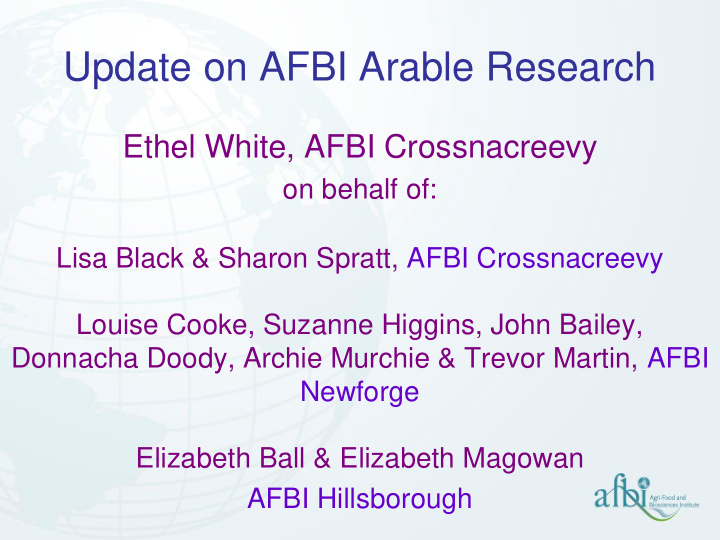



Update on AFBI Arable Research Ethel White, AFBI Crossnacreevy on behalf of: Lisa Black & Sharon Spratt, AFBI Crossnacreevy Louise Cooke, Suzanne Higgins, John Bailey, Donnacha Doody, Archie Murchie & Trevor Martin, AFBI Newforge Elizabeth Ball & Elizabeth Magowan AFBI Hillsborough
Yields of cereals on farm in N Ireland to 2014 9 Wheat Spring barley 8 Winter barley Oats (winter and spring) 7 6 tonnes/hectare 5 4 3 2 1 0 1950 1960 1970 1980 1990 2000 2010 2020
Estimated contribution of improvement in winter wheat varieties to yield increases in GB 1982 – 2007 9 Grain yield (t/ha) 8 7 6 1982 1987 1992 1997 2002 2007 Blue diamonds: national yield, green line spline (3df) fitted to national yield, red line: contribution of variety effect to national yield MacKay et al (2011)
KWS Santiago – along with JB Diego the most popular variety in the UK KWS Santiago - Yield of 102% in NI cf. 105% on HGCA 2015 RL (JB Diego – Yield of 105% in NI cf. 102% on HGCA 2015 RL)
DARD / AFBI Cereal and Potato Variety Evaluation programmes and Information • Tailors the choice for the local farmer • The seed trade in NI provides varieties better suited for NI • Source of expertise for farmers, agricultural advisers, seed merchants, and the agri-food industry
10.0 12.0 0.0 2.0 4.0 6.0 8.0 Yield response to disease control in winter wheat Costello Cougar 10-14 without fungicide 10-14 with fungicide KWS-Lili Britannia Crusoe Revelation Invicta RGT Conversion Evolution Skyfall KWS Croft Icon varieties (2010-2014) Alchemy Panacea Zulu KWS-Trinity KWS-W223 Hyteck Horatio Monterey Delphi Myriad JB-Diego Grafton Energise Panorama SY-111978 SEWC112 Avatar Cubanita Solstice LGW68 Dickens KWS Kielder Beluga Gallant Chilton Leeds RW41186 Cordiale KWS-Santiago Twister KWS Cashel
Can fungicide use (and plant growth regulator use, nitrogen applications) be reliably and consistently adjusted to take account of resistance/susceptibility of varieties to disease (straw damage) ? C ereal I mprovement through V ariety choice and understanding Y ield L imitations CIVYL project: DAFM & DARD funded with Teagasc
Variety-related agronomy and physiology research and KT Disease monitoring on untreated variety trials Straw yields of winter and spring barley varieties Agronomy of quality of: – oats for milling (in GB and NI) – potatoes for processing and pre-packing Biodiversity in cereal crops
Impact of compaction on soil quality and nutrient availability for sustainable and competitive production in grassland and arable farming systems in N Ireland Impact of organic manure application on soil quality & nutrient availability for sustainable & profitable cereal crop production in N Ireland The COMS (Cereals, Organic Manures and Soil) Project (with the Ulster Arable Society, the HGCA and Rothamsted)
Soil Science Suzanne Higgins, AFBI Newforge • Spatial variability within fields → DARD E&I Precision Agriculture Project Proposal ‘Development of precision agriculture techniques to improve the efficiency of nutrient use on farms’ Compaction Greenhouse Gas Emissions Soil fertility / Nutrient management plans Soil conditioners e.g. G – Lime
Defining the nutritive value of cereal for pigs and poultry Elizabeth Ball & Elizabeth Magowan, AFBI Hillsborough DARD/HGCA/Industry funded projects 2013-2016: • Determination and development of NIR prediction equations for the nutritive value of rapeseed meal and DDGS in pig and broiler chicken diets – E Magowan and E Ball • Commercial validation of NIR equations to predict the nutritive value of wheat for broilers – E Ball
Arable Health: DARD Statutory Testing • Brown Rot/Ring Rot testing on potato tubers, river water, processing water & weeds under EU Directives 2006/56/EC & 2006/63/CE • Dickeya testing on potato tubers, river water, processing water and growing plants in support of nil tolerance as laid down in the Plant Health Order (NI) • Virus testing of potato leaflets from growing crops of potato seed in support of the Seed Potato Certification scheme • PCN identification of soil samples from land intended to produce certified potato crops in support of EU directive 2007/33/EC • Detection of arable quarantine pests & diseases (including BNYVV, nematodes & Epitrix spp.)
Arable Health: Research in support of Going for Growth Strategy • Use of bacteriophages to control blackleg through vacuum infiltration in potato tuber seed: 18-month project funded by InvestNI Proof-of-Concept scheme • Monitoring Pathogen Evolution for Sustainable Cropping (MonPesc): a 5-year all-Ireland project funded by the DAFM Research Stimulus fund • AFBI arable pathologists are also involved in commercially funded research trials of eco-friendly products, such as garlic and seaweed extracts, on crops including potato and cereals
Arable Health: Advice and Representation DARD - Technology Transfer: provision of advice and information support of legislative requirement through ad hoc disease identification and problem solving - Provision of scientific advice through representation on UK and EU level committees and plant health steering groups - Provision of inspector training Industry - Commercial testing - Growers’ Workshops - Provision of advice and information (eg. Blightnet and aphid monitoring) (in collaboration with CAFRE) Emergency Response capability
Cereal and potato aphid monitoring Pesticide usage and application Implementing integrated pest management Pest forecasting Targeting pesticides Utilisation of natural enemies
Future work Efficiency of fertiliser N use: • Understanding sources of variation in fertiliser N uptake by crops and developing improved in-season decision-making Soil management: • Over-years optimum cultivation strategies for NI soils & weather (rainfall) • Effects on soil flora, fauna and processes of: – Crop grown – Nutrient source and quantity Optimising the use of varieties: • Understanding sources of variation in yield of cereals, potatoes (and grassland), taking these into account in variety evaluation & KT resilience and sustainable production cf. Climate Change • Potatoes Sustainable intensification - Weeds, agronomy, etc.
Importance of local research Climate Soils How crops grow + biotic & abiotic stresses Threats to agrochemicals Legislative context Markets – oat milling, animal feed + malting, + bread-making Local challenges appropriate solutions impact and contribution in GB, RoI , & …
Recommend
More recommend